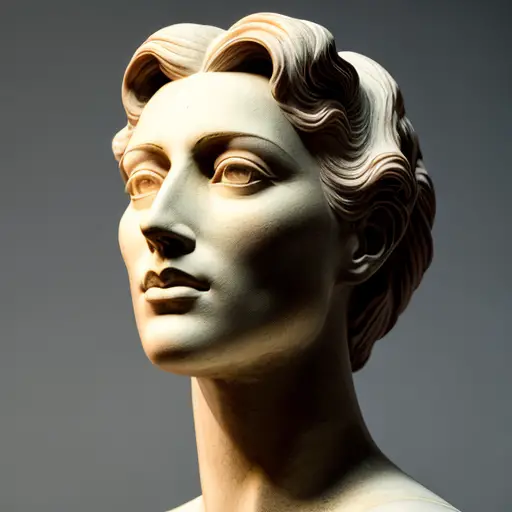Picture this: it's the Renaissance, and the art world is buzzing with excitement. But amidst all the paintbrushes and chisels, there's something else that's shaping the artistic paradigm: humanism. Yes, you heard it right, folks. Humanism, the intellectual movement that made everyone realize that humans are pretty darn important. Suddenly, artists were no longer just painting religious figures with halos and angelic beings floating around. Oh no, they were now capturing the essence of humanity itself. Renaissance painting and sculpture became a playground for these artists to showcase the beauty and complexity of the human form. From Michelangelo's David, with his perfectly sculpted abs that could rival any Greek god, to da Vinci's Mona Lisa, with her enigmatic smile that leaves us all wondering what's so funny, humanism breathed life into art like never before. It was like a Renaissance version of 'Humans of New York,' but with a lot more marble and oil paint. So, next time you find yourself gazing at a Renaissance masterpiece, remember that it's not just a pretty picture; it's a celebration of our very existence.
One interesting fact about how humanism influenced Renaissance painting and sculpture is that it shifted the focus from religious subjects to the celebration of human potential and achievements. Humanist thinkers believed in the importance of individualism, human dignity, and the pursuit of knowledge. As a result, Renaissance artists began to depict secular subjects, such as portraits, mythological scenes, and everyday life, alongside religious themes. This shift in subject matter reflected the humanist belief in the value of human experience and the exploration of the natural world, leading to a more diverse and realistic representation of human emotions, anatomy, and perspective in art.
Imagine a time when art was all about angels, saints, and religious symbolism. Then, along came humanism, shaking things up like a Renaissance party crasher. Suddenly, artists realized that humans were more than just pious subjects; they were complex beings with emotions, flaws, and individuality. Renaissance painting and sculpture became a canvas for celebrating the human form in all its glory. Artists like Botticelli and Titian embraced this newfound freedom, creating masterpieces that showcased the beauty and diversity of humanity. No longer confined to heavenly realms, art now celebrated the everyday, the ordinary, and the extraordinary. Humanism gave artists the license to explore the depths of human nature, capturing the essence of individuals and immortalizing them on canvas or in stone. It was a revolution that brought art back to the people, reminding us all that we are the true masterpieces of this world.

In the world of Renaissance sculpture, humanism was the catalyst for a transformative revolution. No longer were artists content with creating static, lifeless statues. Humanist ideals breathed new life into three-dimensional art, allowing sculptors to capture the essence of humanity in a way that had never been done before. The human form became the ultimate muse, as artists sought to depict the beauty, grace, and complexity of the human body. Sculptors like Donatello and Michelangelo pushed the boundaries of their craft, infusing their works with a sense of realism and emotional depth that was unprecedented.
Humanism's influence on Renaissance sculpture went beyond mere aesthetics. It was a celebration of individuality and the human spirit. Sculptors began to depict real people, capturing their unique features and personalities. No longer were statues generic representations of saints or mythological figures; they became portraits of real individuals, frozen in time. This shift in focus reflected the humanist belief in the importance of the individual and the power of human potential.
Furthermore, humanism brought a newfound appreciation for the human body and its capabilities. Sculptors meticulously studied anatomy, striving for accuracy and realism in their works. They sought to capture the natural movement and fluidity of the human form, creating sculptures that seemed to come alive before the viewer's eyes. The result was a harmonious blend of art and science, as artists merged their technical skills with a deep understanding of human anatomy.
Humanism's impact on Renaissance sculpture was profound and far-reaching. It revolutionized the way artists approached their craft, elevating the human form to the forefront of artistic expression. Sculptures became more than just objects; they became windows into the human experience, inviting viewers to connect with the emotions and stories they portrayed. Humanism breathed life into stone and marble, transforming sculptures into powerful testaments to the beauty and complexity of the human spirit.
Fun fact: Humanism greatly influenced Renaissance painting and sculpture by shifting the focus from religious themes to the celebration of human potential and achievements. This led to the portrayal of realistic human figures with accurate proportions, lifelike expressions, and intricate details, as artists sought to capture the beauty and complexity of the human form. The emphasis on humanism also encouraged artists to explore new techniques and perspectives, resulting in groundbreaking innovations in art during the Renaissance period.
Humanism, with its emphasis on the value and potential of human beings, sparked a revolution in Renaissance art. Painters and sculptors embraced humanist thought, exploring new artistic techniques and themes that celebrated the human experience. Gone were the days of rigid, formulaic compositions. Artists like Leonardo da Vinci and Raphael sought to capture the essence of humanity through their use of perspective, light, and shadow. They meticulously studied the human form, infusing their works with a sense of realism and naturalism that had been absent in art for centuries. Humanist themes also emerged, as artists depicted scenes from everyday life and celebrated the achievements of individuals. The Renaissance became a time of artistic exploration, where the human spirit was celebrated and immortalized on canvas and in stone. Humanism breathed new life into art, transforming it into a powerful medium for expressing the beauty, complexity, and potential of the human experience.